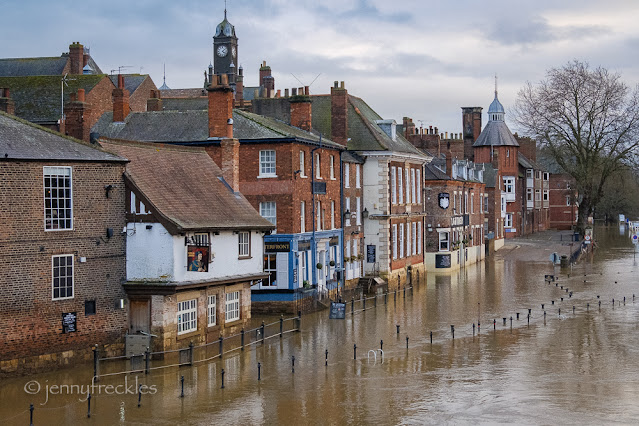I made a visit to York at the weekend; such a lovely, interesting and historic city. When it rains in the Dales and in the valleys up here, all that water makes its way downstream to join the River Ouse which flows through York. It's a fairly regular occurrence therefore that the city floods, at least along the riverbanks. The businesses along here are used to it and have measures in place that mean they can recover fairly quickly, though it must get tedious. Flood alleviation schemes have been installed, so to some extent the flooding you see now is part of what they have decided is acceptable disruption. It's the first time I've ever visited the city when it has been flooded and could see for myself what they have to contend with. It was clear that the water level had already dropped by a couple of feet - you can see the high watermark on the wall of the pub (above). Normally this area looks like THIS. Some of the paths I walked along were slippery with mud and had obviously recently been underwater and the river was much wider than it normally is, with the riverside promenades completely submerged. The rest of the city carries on as normal.






Oh no. Much water with no place to go, except slowly down. That patio al fresco would be a hoot if I wore a wet suit perhaps...and had a very hot cup of something! We're in for a day long rain here, but fortunately it's above freezing.
ReplyDeleteThanks for showing; I don't think I've ever heard of this before. (50 years since I visited York myself, and then only for a day...)
ReplyDeleteThat must be a horrible disruption for the businesses.
ReplyDeleteSeems rather relentless with the water this year.....hard to pick between it and drought, both extremes....
ReplyDeleteWhile you explained that the businesses are used to the flooding and able to carry, it does seem to be disruptive to visitors as well. Thanks for showing the impact.
ReplyDeleteThat is a lot. I'm so used to being well above the water, but there are areas here that were significantly hit by high water in recent years during spring snowmelt.
ReplyDelete